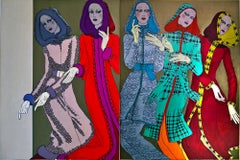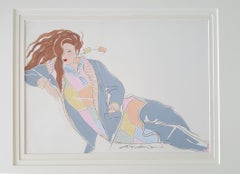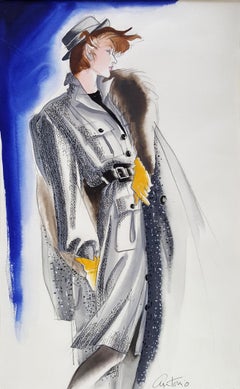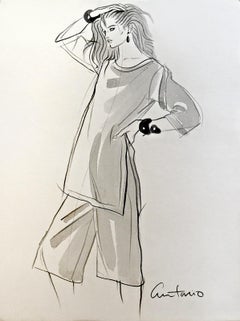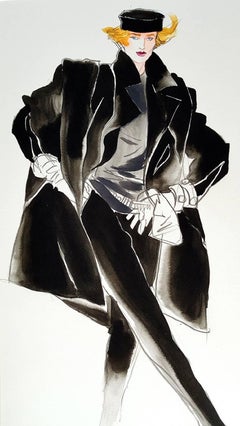Antonio Lopez Figurative Drawings and Watercolors
Puerto Rican, 1943-1987
Antonio (as he signed his work) was and remains one of the most highly regarded and influential figures in the fashion world. While not initially known as a photographer, Antonio was rarely without his favorite Instamatic camera, and as his career progressed he turned increasingly to photography to create fashion stories, portraits, and elaborate mise-en-scènes.
This exhibition – the first to focus exclusively on Antonio’s photographs - features a selection of the unique Instamatic prints from the 1970s that were his photographic form. Developed and printed by Kodak, these prints were either mounted by Antonio or stored in the original yellow Kodak envelopes that the film was processed and delivered in. As Antonio never sent the negatives back for re-printing each print is unique.
While primarily known for his fashion illustrations, Antonio did not treat his photographs lightly, assembling them in grids and pairs to create dynamic and visceral patterns. While the prints may superficially resemble Andy Warhol’s Polaroids because of their size and period, Antonio’s Kodak prints are a burst of energy to Warhol’s more classical studies. While Warhol’s Polaroids were mostly the basis for future painted portraits, Antonio’s photographs were an end to themselves.
A serial Svengali, as the writer Karin Nelson noted: “Lopez brilliantly transformed the women in his world. Under his tutelage, Jerry Hall, a long tall Texan he met at Paris’s Club Sept, evolved into a golden goddess. He put Jessica Lange in gold lamé evening dresses after discovering her in Paris studying mime, and gave aspiring model Tina Lutz her start (and an introduction to future husband Michael Chow); and, by spotlighting Pat Cleveland, a mixed-race model with a theatrical streak, he helped break down the color barrier in high fashion.” Other favorite subjects were the young Grace Coddington, Grace Jones, and Paloma Picasso.
Antonio Lopez was born in Utuado, Puerto Rico in 1943. His family moved to Spanish Harlem in 1950 where he showed early promise as an artist making drawings for his mother who was a seamstress and dressmaker. In the early 1960s he enrolled on a course at the Fashion Institute of Technology (FIT) in New York where he met Juan Ramos who became his life long collaborator. He joined The New York Times in 1963 but was soon freelancing for Harper’s Bazaar, British Vogue and French Elle. In 1969 he moved to Paris with Ramos where he was commissioned by all the leading fashion magazines. He returned to New York in 1975 creating numerous covers and picture stories for Andy Warhol’s Interview Magazine.
Antonio died in Los Angeles 1987. He was forty four years old.(Biography provided by Danziger Gallery)
to
8
7
1
4
3
1
Overall Height
to
Overall Width
to
2
2
1
1
1
8
6
6
5
4
3
2
2
8
1
7
29
723
326
196
132
7
7
5
4
1
Artist: Antonio Lopez
Five Fashion Models Wearing Hoodies Vogue Patterns 1970s Fashion - Puerto Rican
By Antonio Lopez
Located in Miami, FL
Famed Puerto Rican Fashion Illustrator Antonio Lopez creates an oversized illustration for Vogue Patterns Magazine 1971. He uses a variety of media whic...
Category
1970s Modern Antonio Lopez Figurative Drawings and Watercolors
Materials
Paper, Watercolor, Mixed Media
Art Deco Style Fashion Illustration for High Fashion Magazine, Vogue Magazine?
By Antonio Lopez
Located in Miami, FL
Fashion Illustration for High Fashion Magazine . Impeccably rendered with quick flat brush strokes in glorious pastel colors , Signed lower right Ant...
Category
1980s Art Deco Antonio Lopez Figurative Drawings and Watercolors
Materials
Pencil, Gouache
Vogue Magazine, Elegant Fashion Illustration for Adel Simpson
By Antonio Lopez
Located in Miami, FL
Vogue USA, Fashion Illustration. Meticulously drawn in a descriptive and yet creative way. Antonio's full mastery of his art is on full display. Signed lower right. The work is arch...
Category
1980s Post-Impressionist Antonio Lopez Figurative Drawings and Watercolors
Materials
Gouache, Watercolor, Pencil
Fashion Model full figure in profile
By Antonio Lopez
Located in Miami, FL
Fashion Illustration. Work is unframed. Free standing heavy watercolor paper loosely hinged to board. Excellent condition.
Category
1980s Contemporary Antonio Lopez Figurative Drawings and Watercolors
Materials
Pencil, Watercolor
Stylish 80's Women, Fashion Illustration
By Antonio Lopez
Located in Miami, FL
Work is not framed. Done for a Manhattan fashion house in the 1980's
Category
1980s Antonio Lopez Figurative Drawings and Watercolors
Materials
Watercolor, Ink, Pencil
Vogue Magazine Hi Fashion Illustration (Stephen Sprouse)
By Antonio Lopez
Located in Miami, FL
Vogue Magazine Fashion Illustration (Stephen Sprouse)
Antonio's mature style is on full display with a few quick strokes of the brush he is exemplifying the epitome of style and clas...
Category
1980s Impressionist Antonio Lopez Figurative Drawings and Watercolors
Materials
Gouache
Halston , Vogue Magazine Illustration, Italy
By Antonio Lopez
Located in Miami, FL
Signature: Published Vogue Italy Client Halston Double Signature Signed lower right Antonio Also signed Halston Graphic remarks were written in pencil by Halston. work is elegantly m...
Category
1980s Post-Impressionist Antonio Lopez Figurative Drawings and Watercolors
Vogue USA, Fashion Illustration
By Antonio Lopez
Located in Miami, FL
Vogue USA, Fashion Illustration. Meticulously drawn in a descriptive and yet creative way. Antonio's full mastery of his art is on full display...
Category
1980s American Impressionist Antonio Lopez Figurative Drawings and Watercolors
Materials
Pencil, Gouache
Related Items
Les Gilles de Binche - 19th Century Watercolor, Figures Belgian Carnival H Duhem
By Henri Duhem
Located in Marlow, Buckinghamshire
Watercolour on paper circa 1920 by Henri Duhem depicting The Gilles at the Carnival of Binche, Belgium. Signed and titled lower left. This painting is not currently framed but a suit...
Category
Early 20th Century Impressionist Antonio Lopez Figurative Drawings and Watercolors
Materials
Watercolor, Paper
The Abduction of the Sabine Women , a Renaissance drawing by Biagio Pupini
Located in PARIS, FR
This vigorous drawing has long been attributed to Polidoro da Caravaggio: The Abduction of the Sabine Women is one of the scenes that Polidoro depicted between 1525 and 1527 on the façade of the Milesi Palazzo in Rome. However, the proximity to another drawing inspired by this same façade, kept at the Ecole des Beaux-Arts, and to other drawings inspired by Polidoro kept at the Musée du Louvre, leads us to propose an attribution to Biagio Pupini, a Bolognese artist whose life remains barely known, despite the abundant number of drawings attributed to him.
1. Biagio Pupini, a Bolognese artist in the light of the Roman Renaissance
The early life of Biagio Pupini, an important figure of the first half of the Cinquecento in Bologna - Vasari mentions him several times - is still poorly known. Neither his date of birth (probably around 1490-1495) nor his training are known. He is said to have been a pupil of Francesco Francia (1450 - 1517) and his name appears for the first time in 1511 in a contract with the painter Bagnacavallo (c. 1484 - 1542) for the frescoes of a church in Faenza. He then collaborated with Girolamo da Carpi, at San Michele in Bosco and at the villa of Belriguardo.
He must have gone to Rome for the first time with Bagnacavallo between 1511 and 1519. There he discovered the art of Raphael, with whom he might have worked, and that of Polidoro da Caravaggio. This first visit, and those that followed, were the occasion for an intense study of ancient and modern art, as illustrated by his abundant graphic production.
Polidoro da Caravaggio had a particular influence on the technique adopted by Pupini. Executed on coloured paper, his drawings generally combine pen, brown ink and wash with abundant highlights of white gouache, as in the drawing presented here.
2. The Abduction of the Sabine Women
Our drawing is an adaptation of a fresco painted between 1525 and 1527 by Polidoro da Caravaggio on the façade of the Milesi Palace in Rome. These painted façades were very famous from the moment they were painted and inspired many artists during their stay in Rome. These frescoes are now very deteriorated and difficult to see, as the palace is in a rather narrow street.
The episode of the abduction of the Sabine women (which appears in the centre of the photo above) is a historical theme that goes back to the origins of Rome and is recounted both by Titus Livius (Ab Urbe condita I,13), by Ovid (Fasti III, 199-228) and by Plutarch (II, Romulus 14-19). After killing his twin brother Romus, Romulus populates the city of Rome by opening it up to refugees and brigands and finds himself with an excess of men. Because of their reputation, none of the inhabitants of the neighbouring cities want to give them their daughters in marriage. The Romans then decide to invite their Sabine neighbours to a great feast during which they slaughter the Sabines and kidnap their daughters.
The engraving made by Giovanni Battista Gallestruzzi (1618 - 1677) around 1656-1658 gives us a good understanding of the Polidoro fresco, allowing us to see how Biagio Pupini reworked the scene to extract this dynamic group.
With a remarkable economy of means, Biagio Pupini takes over the left-hand side of the fresco and depicts in a very dense space two main groups, each consisting of a Roman and a Sabine, completed by a group of three soldiers in the background (which seems to differ quite significantly from Polidoro's composition).
The balance of the drawing is based on a very strongly structured composition. The drawing is organised around a median vertical axis, which runs along both the elbow of the kidnapped Sabine on the left and the foot of her captor, and the two main diagonals, reinforced by four secondary diagonals. This diamond-shaped structure creates an extremely dynamic space, in which centripetal movements (the legs of the Sabine on the right, the arm of the soldier on the back at the top right) and centrifugal movements (the arm of the kidnapper on the left and the legs of the Sabine he is carrying away, the arm of the Sabine on the right) oppose each other, giving the drawing the appearance of a whirlpool around a central point of support situated slightly to the left of the navel of the kidnapper on the right.
3. Polidoro da Caravaggio, and the decorations of Roman palaces
Polidoro da Caravaggio was a paradoxical artist who entered Raphael's (1483 - 1520) workshop at a very young age, when he oversaw the Lodges in the Vatican. Most of his Roman work, which was the peak of his career, has disappeared, as he specialised in facade painting, and yet these paintings, which are eminently visible in urban spaces, have influenced generations of artists who copied them abundantly during their visits to Rome.
Polidoro Caldara was born in Caravaggio around 1495-1500 (the birthplace of Michelangelo Merisi, known as Caravaggio, who was born there in 1571), some forty kilometres east of Milan. According to Vasari, he arrived as a mason on the Vatican's construction site and joined Raphael's workshop around 1517 (at the age of eighteen according to Vasari). This integration would have allowed Polidoro to work not only on the frescoes of the Lodges, but also on some of the frescoes of the Chambers, as well as on the flat of Cardinal Bibiena in the Vatican.
After Raphael's death in 1520, Polidoro worked first with Perin del Vaga before joining forces with Maturino of Florence (1490 - 1528), whom he had also known in Raphael's workshop. Together they specialised in the painting of palace façades. They were to produce some forty façades decorated with grisaille paintings imitating antique bas-reliefs.
The Sack of Rome in 1527, during which his friend Maturino was killed, led Polidoro to flee first to Naples (where he had already stayed in 1523), then to Messina. It was while he was preparing his return to the peninsula that he was murdered by one of his assistants, Tonno Calabrese, in 1543.
In his Vite, Vasari celebrated Polidoro as the greatest façade decorator of his time, noting that "there is no flat, palace, garden or villa in Rome that does not contain a work by Polidoro". Polidoro's facade decorations, most of which have disappeared as they were displayed in the open air, constitute the most important lost chapter of Roman art of the Cinquecento. The few surviving drawings of the painter can, however, give an idea of the original appearance of his murals and show that he was an artist of remarkable and highly original genius.
4. The façade of the Milesi Palace
Giovanni Antonio Milesi, who commissioned this palace, located not far from the Tiber, north of Piazza Navona, was a native of the Bergamo area, like Polidoro, with whom he maintained close friendly ties. Executed in the last years before the Sack of Rome, around 1526-1527, the decoration of Palazzo Milesi is considered Polidoro's greatest decorative success.
An engraving by Ernesto Maccari made at the end of the nineteenth century allows us to understand the general balance of this façade, which was still well preserved at the time. The frescoes were not entirely monochrome, but alternated elements in chiaroscuro simulating marble bas-reliefs and those in ochre simulating bronze and gold vases...
Category
16th Century Old Masters Antonio Lopez Figurative Drawings and Watercolors
Materials
Ink, Gouache, Pen
Original French Art Deco Gouache Illustration Drawing by J. Hilly
Located in Atlanta, GA
An original Art Deco illustration hand-painted with ink and gouache on paper. The drawing features two elegant women with large windows and drapery in the background. This illustrati...
Category
1930s Art Deco Antonio Lopez Figurative Drawings and Watercolors
Materials
Paper, Ink, Gouache
H 15.56 in W 12.01 in D 1.97 in
Jules-Eugène Lenepveu (1819-1898) Portrait of a man in profile, signed drawing
Located in Paris, FR
Jules-Eugène Lenepveu (1819-1898)
Portrait of a man in profile
signed on the lower right
Pencil and heightenings of white gouache on paper
19.5 x 13 cm
Framed : 29 x 22.7 cm
Jules-Eugène Lenepveu is of course particularly well known for his large-scale paintings, such as the one on the ceiling of the Paris Opera, but his work here is much more delicate and intimate. We recognise the artist's mastery of talent, but the play of textures, with its highlights of white that enliven and illuminate the model's face, is also very subtle.
There's a particularly charming sense of life and impression of light.
Jules-Eugène Lenepveu was born in Angers on 12 December 1819, on the site of the street that now bears his name, into a family of small shopkeepers. The painter showed a deep attachment to his family throughout his life through his correspondence and the many portraits of his relatives.
He entered the drawing school in Angers in 1833, where he was a pupil of Jean-Michel Mercier. There he rubbed shoulders with the sculptor Ferdinand Taluet. He arrived in Paris in 1837 and entered the Beaux-Arts, where he was officially admitted to François-Édouard Picot's studio in 1838. He exhibited his work "L'Idylle" at the Salon of 1843 and, that same year, left for his first visit to Italy. He was awarded the Second Prix de Rome in 1843 for "Cincinnatus recevant les députés du Sénat" (Cincinnatus receiving the deputies of the Senate), then the First Prize in 1847 for "La Mort de Vitellius" (The Death of Vitellius).
A resident at the Villa Médicis from 1848, he was surrounded by painters Alexandre Cabanel, Léon Benouville, Gustave Boulanger, Félix Barrias...
Category
1860s Romantic Antonio Lopez Figurative Drawings and Watercolors
Materials
Gouache, Pencil
François-Maurice Roganeau (1883-1973) Portrait of young man 1947, watercolor
Located in Paris, FR
François-Maurice Roganeau (1883-1973)
Portrait of a young man, 1947
signed and dated lower left
Titled Guy Ernoult (name of the sitter) on the upper part
27 x 22 cm
in a beautiful f...
Category
1940s Art Deco Antonio Lopez Figurative Drawings and Watercolors
Materials
Watercolor, Pencil
Superb Stylish Vintage Fashion Design Painting Artist Stamped
Located in Cirencester, Gloucestershire
Very stylish, unique and original 1950's fashion design, no doubt of Parisian origin.
The painting, executed in gouache and pencil, is stamped verso by its designer Claude Monnat. ...
Category
Mid-20th Century Art Deco Antonio Lopez Figurative Drawings and Watercolors
Materials
Pencil, Gouache
H 12.5 in W 9.75 in D 0.1 in
Richard Caton Woodville II (1856 - 1927) 1794 War Balloon Aquarell England 1910
By Richard Caton Woodville Jr.
Located in Meinisberg, CH
Richard Caton Woodville II
(British, 1856 - 1927)
The French Aerostatic Corps - The first War Balloon The launching of the L'Entreprenant used by the French Army under General Jourd...
Category
1910s English School Antonio Lopez Figurative Drawings and Watercolors
Materials
Paper, Watercolor, Gouache, Cardboard
Free Shipping
H 15.56 in W 22.25 in D 1.58 in
Surrealist Gouache and Watercolour on Paper, 'Sunday School Ghosts'.
Located in Cotignac, FR
Surrealist watercolour and gouache on handmade paper by British artist Derek Carruthers. Signed bottom right and signed, dated and titled 'Sunday School Ghosts' to the reverse.
A wo...
Category
21st Century and Contemporary Surrealist Antonio Lopez Figurative Drawings and Watercolors
Materials
Acrylic, Gouache, Watercolor, Handmade Paper
H 22.45 in W 29.93 in D 0.08 in
Original Graphic Hungarian Illustration Art Emma Heinzelmann Children's Book Art
Located in Surfside, FL
Original vintage gouache painting on poster board by Emma Heinzelmann (Hungarian, born 1930). Hungarian Peasant art, children fairytale themes, in psychedelic pop colors of the era.This painting that depicts figures including a crowned pig, and a princess in a bed. Artist signature above bed. Housed in chrome mid century frame.
Framed: 19.5 X 25.5 image is 14.75 X 21.25.
Emma Heinzelmann ( Nyírbátor , March 14 , 1930 - ) Munkácsy Prize-winning Hungarian graphic designer and illustrator.
Heinzelmann is a Hungarian children's book illustrator and graphic poster artist, who started her career during the 1950’s. She has a very unique drawing style that resembles children’s book illustrations. Working in psychedelic pop colors of the era. She Initially she studied to be a costume designer but she soon turned to graphic design. She graduated in 1950 from the clothing design department at the Junior High School in Török Pál Street which operated under the name Szépmíves Lyceum from 1946 to 1950. His master was György Farkas, a ceramicist, painter and sculptor. She creates her compositions using mainly watercolor and gouache paint. She often worked on illustrations for children’s books, since her style fits their themes. Her posters show the same playful Hungarian Folk Art style. She has produced artwork in almost all areas of applied graphics. posters, commemorative cards, designed album covers, postcards, advertising graphics, slide films, animation and cartoons. Her drawings were published in Dörmögő Dömötör and Kisdobos among others as well as in children's magazines. An entire generation of children grew up with her book illustrations, reading the fairy tales of Wilhelm Hauff or Hans Christian Andersen. Her story books and drawings are known well beyond our borders. She illustrated nearly 80 storybooks. She is a contemporary of Maurice Sendak and William Steig. Her work is of the same genre as the iconic Polish Cyrk poster artists.
In her original fine art graphics grotesque and bitter elements often prevail, her figures are playfully ironic. Her drawings are made in a variety of ways, from pencil drawings to watercolor painting to collage techniques, from decorative spot effects to lace-like line drawings. She is no stranger to a kind of Art Nouveau influence, but it is always individual. It was never beautiful, but over the years its color scheme changed, thus confirming the lines of József Somogyi quoted earlier. She had several individual exhibitions, and for more than 10 years as a member of the Papp-Gábor group, her works could be seen in Dorottya Street.
In 2009 , the book of art historian András Székely was published by Holnap Könyvkiadó under the title Emma Heinzelmann: fairy tales in the drawing.
Awards and recognitions
Lot Prize (International Poster Biennale, Warsaw) (1972)
Ministry of Culture Award (1977, 1979)
Brno Graphic Biennale (Bronze Award) (1980)
Worker's Award (1984)
Children's Book of the Year Award (1984)
IBBY Andersen Diploma (1988)
Hamburg Lifetime Achievement Award (1990)
Albert Star Award (1992)
Noémi Ferenczy Award (2005)
Munkácsy Award (1984)
Solo Exhibitions:
Thought Bookstore, Budapest (1965)
Cultural Center, Nyíregyháza (1974)
Little Gallery, Komárom (1982)
Art Gallery, Budapest. (1990)
Vác (2010)
Selected group exhibitions:
International Children's Book Fair and Exhibition, Bologna (1971-1975)
International Graphic Biennale, Brno (1966-1985)
BIB (Children's book illustration biennial), Bratislava (1970-1985)
XXXVI. Venice Biennale, Venice (1972)
ARC. International Poster Biennale, Warsaw (1972)
International Poster Triennale (B) (1972-1974)
Weekdays, graphic exhibition, (1975)
Calligraphy and typography, Institute of Cultural Relations, Budapest (1977)
"Falrahányt pea", graphic exhibition, Institute of Cultural Relations, Budapest.(1978)
International Poster Triennale (B) (1978)
National Poster Exhibitions, Art Gallery, Budapest (1978)(1980)
International Poster Exhibition (IR) (1979)
Slide films:
Fairy tales with Emma Heinzelmann's drawings:
Under the Shore (1981)
Goose Party (1981)
Take a Little Trumpet (1982)
The Bremen Town...
Category
Mid-20th Century Folk Art Antonio Lopez Figurative Drawings and Watercolors
Materials
Gouache
Angelic Ruth Cobb Watercolor, Signed
Located in Larchmont, NY
Ruth Cobb (American, 1914-2008)
Untitled, c. 20th century
Watercolor and mixed media on paper
Sight: 19 3/4 x 28 1/2 in.
Framed: 33 1/2 x 41 3/4 x 1 3/4 in.
Signed lower right
Born ...
Category
20th Century American Impressionist Antonio Lopez Figurative Drawings and Watercolors
Materials
Paper, Mixed Media, Watercolor
British Mid 20th Century Impressionist Painting Elegant Figures Gossiping
Located in Cirencester, Gloucestershire
Frank Duffield (British, 1908-1982)
original gouache painting on board, unframed
size: 15 x 11 inches
condition: overall very good, minor wear to the edges as is normal for an unfram...
Category
Mid-20th Century Impressionist Antonio Lopez Figurative Drawings and Watercolors
Materials
Gouache
Mid-Century Portrait of an Elegant Woman (unfinished)
By Joseph Yeager
Located in Soquel, CA
Portrait of an elegant woman by Joseph Yeager (American, 20th Century). This piece is unsigned, but was acquired with a collection of Yeager work directly from the estate. This piece...
Category
1960s American Impressionist Antonio Lopez Figurative Drawings and Watercolors
Materials
Paper, Watercolor, Pencil
H 30 in W 22 in D 0.03 in
Previously Available Items
Fashion Model in Red Illustration for Italian Vogue
By Antonio Lopez
Located in Miami, FL
Woman in red 3/4 view, client S. Burroughs
Work is elegantly matted but not framed. Unsigned
Category
1980s Impressionist Antonio Lopez Figurative Drawings and Watercolors
Materials
Watercolor, Pencil
Woman in Red, Vogue Magazine, S. Burroughs,
By Antonio Lopez
Located in Miami, FL
For Vogue Italy. Designer: S. Burroughs,
Beautifully matted on archival board. Not Framed . Not signed,
Category
1980s Antonio Lopez Figurative Drawings and Watercolors
Materials
Watercolor, Gouache, Pencil
Female with Hand in Hair
By Antonio Lopez
Located in Miami, FL
The work is not framed or matted. Free standing heavy watercolor paper loosely hinged to board
Condition is excellent
Signature: Signed Antonio lower right.
Purchased directly from...
Category
1980s Contemporary Antonio Lopez Figurative Drawings and Watercolors
Materials
Watercolor, Ink, Pencil
Vogue Magazine Illustration , Perry Ellis
By Antonio Lopez
Located in Miami, FL
Work is beautifully matted but not framed. Condition is excellent
Signature: Signed Antonio lower right
Vogue Magazine, Perry Ellis , 1980
Ink and wate...
Category
1980s Post-Impressionist Antonio Lopez Figurative Drawings and Watercolors
Materials
India Ink, Watercolor, Carbon Pencil
Eha and Helmut Newton
By Antonio Lopez
Located in Long Island City, NY
Artist: Antonio Lopez, Puerto Rican (1943 - 1987)
Title: Eha and Helmut Newton
Year: circa 1985
Medium: Pencil and Watercolor on Paper, signed l.c.
Size: 22 x 29.5 in. (55.88 ...
Category
1980s Contemporary Antonio Lopez Figurative Drawings and Watercolors
Materials
Pencil, Watercolor
Antonio Lopez figurative drawings and watercolors for sale on 1stDibs.
Find a wide variety of authentic Antonio Lopez figurative drawings and watercolors available for sale on 1stDibs. You can also browse by medium to find art by Antonio Lopez in paint, watercolor, pencil and more. Much of the original work by this artist or collective was created during the 20th century and is mostly associated with the Post-Impressionist style. Not every interior allows for large Antonio Lopez figurative drawings and watercolors, so small editions measuring 11 inches across are available. Customers who are interested in this artist might also find the work of Joseph Yeager, Martha Walter, and David Becker. Antonio Lopez figurative drawings and watercolors prices can differ depending upon medium, time period and other attributes. On 1stDibs, the price for these items starts at $3,500 and tops out at $18,000, while the average work can sell for $8,600.
